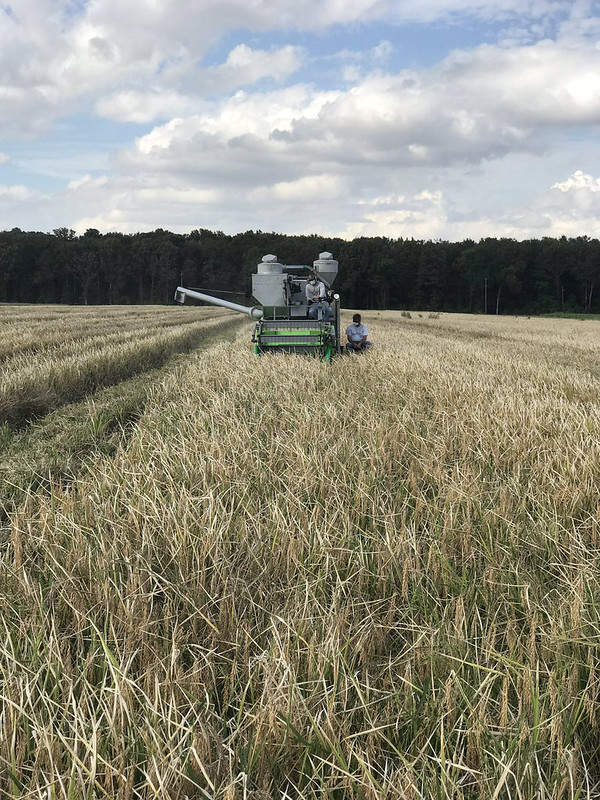May 29, 2020
Global market prices for rice recede from peak, but some remain above pre-pandemic levels
By Ryan McGeeney
U of A System Division of Agriculture
Fast Facts:
- Rice prices ease as some countries relax COVID-related export restrictions
- India has most competitive prices, still plagued by supply chain issues
- U.S. might see rise in planted rice acres
(515 words)
(Download this story in MS Word format here.)
FAYETTEVILLE, Ark. — As several rice-exporting countries around the world begin to ease COVID-related export and other trade restrictions, global prices have become more competitive, falling from their peak earlier in May, according to an economic impact report from the University of Arkansas System Division of Agriculture.
Alvaro Durand-Morat, research assistant professor for the Division of Agriculture and co-author of the report, said that while prices in the United States remain higher than pre-pandemic levels, global trade and competition have brought international prices to heel.
Durand-Morat said that many key rice-exporting countries, including Myanmar and Cambodia among others, are beginning to resurface after several months of import restrictions designed to weather the impact of the COVID-19 pandemic.
“As the COVID situation evolves, some countries have done quite well, and they’re relaxing those export restrictions, and that’s easing prices,” he said.
“Prices in the United States have been driven by short supply more than anything else,” Durand-Morat said. “But in India and Thailand, for example, they’ve gone back to pre-COVID-19 levels. In Vietnam, they remain about $100 above pre-COVID prices. Overall, prices have become much more competitive after the peak a few weeks ago.”
India, the world’s largest rice exporter, continues to struggle with the spread of the virus to a large degree, causing delays throughout its supply chain.
“While the country has the lowest, most competitive price right now, they’re by no means back to full activity on the export side of things,” Durand-Morat said. “They still have stay-at-home orders, and that’s delaying shipments.”
There is no way of knowing when the global rice market will truly return to pre-COVID levels of efficiency, he said.
“Who knows where this pandemic will go?” he said. “Some countries, such as Vietnam, have done a very good job, domestically speaking, in terms of controlling the pandemic. So, I’d expect them to be back to normal sooner, rather than later. India’s outlook, on the other hand, is not very optimistic. It’s very hard for them to maintain social distance, and their cases are increasing. They have plenty of rice to export, but if the pandemic is not under control, we could expect their export capacity to suffer and put pressure on the global rice market.”
Durand-Morat was one of four authors who contributed to the economic impact update report.
Impact on U.S. rice
Given the current stage in the U.S. agricultural planting cycle, it’s unclear what
opportunities the current situation may present for American producers in 2020.
“With planting decisions, we know that for the last two months, all the economic factors favor rice,” Durand-Morat said. “When everything’s said and done, we will likely see an increase in rice acres.
“Is this an opportunity for US agriculture? I think if we had our choice, no one would have chosen this situation,” he said. “It continues to be a highly risky environment for agriculture, and more so for cotton and corn; less so for soybean and rice.”
To learn about extension programs in Arkansas, contact your local Cooperative Extension Service agent or visit www.uaex.uada.edu. Follow us on Twitter at @AR_Extension.
About the Division of Agriculture
The University of Arkansas System Division of Agriculture’s mission is to strengthen agriculture, communities, and families by connecting trusted research to the adoption of best practices. Through the Agricultural Experiment Station and the Cooperative Extension Service, the Division of Agriculture conducts research and extension work within the nation’s historic land grant education system.
The Division of Agriculture is one of 20 entities within the University of Arkansas System. It has offices in all 75 counties in Arkansas and faculty on five system campuses.
Pursuant to 7 CFR § 15.3, the University of Arkansas System Division of Agriculture offers all its Extension and Research programs and services (including employment) without regard to race, color, sex, national origin, religion, age, disability, marital or veteran status, genetic information, sexual preference, pregnancy or any other legally protected status, and is an equal opportunity institution.
# # #
Media contact:
Ryan McGeeney
Communications Services
University of Arkansas System Division of Agriculture
Cooperative Extension Service
(501) 671-2120
rmcgeeney@uada.edu
